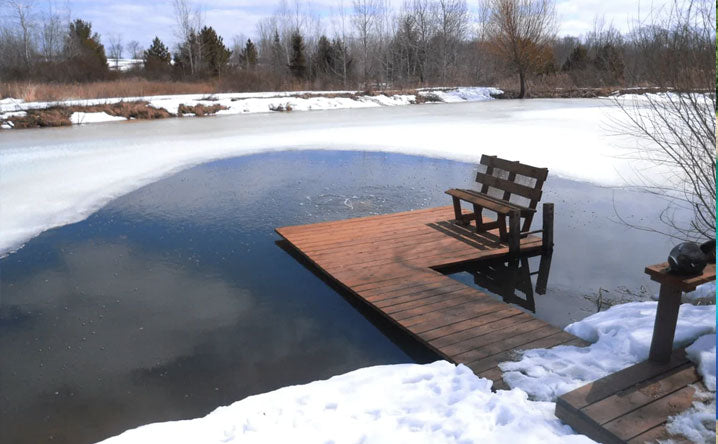Introduction: The Importance of Pond Aeration in Winter
Winter brings unique challenges to pond ecosystems. Ice cover, diminished oxygen levels, and stagnant water can threaten your pond's delicate life balance. Smith Creek Fish Farm, a leader in pond and lake management, emphasizes the critical role of winter pond aeration in maintaining a healthy aquatic environment, ensuring the vitality of pond life through the colder months.
Understanding Your Pond's Winter Needs
During winter, ponds undergo significant ecological changes. The lower temperatures, reduced sunlight, and ice cover dramatically alter cold water quality and living conditions for aquatic life. Understanding these seasonal dynamics is essential for effective pond management, especially in regions with harsh winters.
Why Aerate Your Pond in Winter?
Oxygen depletion and toxic gas accumulation under the ice are significant threats during winter. Winter pond aeration combats these challenges, sustaining winter fish health, maintaining warm water quality, and preventing complete freezing. A well-aerated pond maintains a healthy environment, ensuring the survival of fish and other aquatic organisms.
Benefits of Winter Pond Aeration
Consistent oxygen supply, crucial for aquatic life, is the primary benefit of using a winter pond aerator. It prevents fish kill, maintains an ecological balance, reduces harmful gas accumulation, and supports a healthy population of beneficial bacteria essential for breaking down organic matter.
Comprehensive Winter Pond Aeration Methods
Different methods of winter pond aeration cater to various needs and pond types.
Using a De-Icer: Pros and Cons
De-icers keep a part of the pond free from ice, facilitating gas exchange. However, they don’t actively circulate or oxygenate the water. In smaller ponds or as a supplementary measure, they can be effective.
Using a Winter Pond Aerator: Types and Uses
Pond aerators, like a pond bubbler for winter, actively circulate and add oxygen to the water. Essential for more extensive or profound ponds, they ensure thorough aeration and are indispensable in maintaining overall pond health. Bottom diffusers should be moved into two or threesfeet of water so the ice will remain open for gas exchange but the warm watter below the thermocline will remain to give a warm sanctuary for your fish.
Combining a De-Icer and Pond Aerator: Maximizing Efficiency
Combining a de-icer with a pond aerator for winter provides both open water and active aeration. We recommend this comprehensive approach for optimal winter pond care.
Tailoring Aeration to Different Pond Types
The proper aeration method depends on your pond’s size, depth, and aquatic life. Smith Creek Fish Farm offers personalized solutions, ensuring optimal aeration for any pond, from small decorative ponds to significant fish habitats.
Equipment Selection Guide
Selecting the right equipment, such as a winter pond aerator or pond water circulator, involves considering specific pond characteristics. Our diverse product range caters to various needs, ensuring that every pond owner can find the ideal aeration solution.
DIY Winter Pond Aeration: A Step-by-Step Guide
For the DIY enthusiast, installing a pond bubbler for winter is a rewarding project that enhances your pond's health and aesthetic appeal. Here's how to set up a basic aeration system:
- Select the Right Aerator: Choose a pond bubbler suitable for the size and depth of your pond. We offer a variety of options tailored to different pond needs.
- Positioning Your Aerator: Place your aerator in a strageic location in the pond where maximum circulation will be achieved, but disruption to the bottom mos layer of warm water is not disturbed. Avoid areas too close to the desirable aquatic plants, as excessive aeration might disturb their root systems. Locating your aerator neer the dock can help prevent ice damage and extend the life of your dock.
- Power Supply: Ensure a reliable power source is available. Use a ground fault circuit interrupter (GFCI) for safety, and consider weatherproofing connections to protect against winter elements.
- Installation: Submerge the aerator following the manufacturer's instructions. Secure it adequately to ensure it remains in place.
- Testing: Once installed, test your aerator to ensure it's working correctly. You should see a noticeable difference in water movement and aeration.
- Regular Checks: Throughout winter, regularly check the aerator to ensure it's functioning correctly and clear any snow or debris that may accumulate around it. Aerator tubing should be buried deep enough and sloped downward towards the pond without low spots to prevent condensation from freezing in the hose and preventing air flow.
- Frozen air hose: If ice does develop in one of your airlines you can gently pour automotive dry gas down the hose. The dry should make its way to the ice and alow air to flow freely again.
Remember, while DIY installation can be effective, always follow safety guidelines and manufacturer instructions.
Professional Installation and Maintenance
Our professional installation and maintenance services for pond and lake management guarantee the optimal functionality of your aeration system. Here's why professional services are advantageous:
- Expert Installation: Professionals ensure correct installation, which is crucial for the system's efficiency and durability.
- Customized Solutions: Experts provide tailored solutions based on your pond's needs, enhancing the system's effectiveness.
- Regular Maintenance: Scheduled maintenance checks prevent potential issues and prolong the system's lifespan.
- Troubleshooting Expertise: Professionals can quickly identify and resolve issues that might be challenging for a layperson.
Investing in professional services ensures peace of mind and maintains the health and beauty of your pond.
Environmental Considerations and Best Practices
Adopting eco-friendly aeration practices is vital for sustainable pond management. Consider the following:
- Energy-Efficient Equipment: Choose aerators with low energy consumption to minimize environmental impact.
- Solar-Powered Options: Consider solar-powered aerators for a more sustainable solution.
- Regular Equipment Checks: Ensure your aeration system runs efficiently to reduce energy waste.
- Eco-Friendly Practices: Complement aeration with natural pond management practices, such as planting native vegetation and maintaining a natural balance.
Sustainable practices not only benefit your pond but also contribute to environmental conservation.
Troubleshooting Common Winter Aeration Issues
Common winter aeration challenges include insufficient aeration, equipment malfunction, and ice formation. Here's how to address these issues:
- Poor Aeration: If aeration seems inadequate, check for blockages in the system and ensure the aerator is positioned correctly for maximum effectiveness.
- Equipment Malfunction: Regularly inspect your aerator for signs of wear or damage. Immediate repair or replacement may be necessary to prevent further issues.
- Unexpected Ice Formation: While aerators help reduce ice formation, extreme temperatures can still lead to ice. If this occurs, gently remove the ice around the aerator. Avoid harsh methods like breaking the ice, which can harm aquatic life.
Regularly monitoring and maintaining your aeration system can effectively troubleshoot and prevent common issues, ensuring a healthy and vibrant pond throughout winter.
Conclusion: Ensuring a Healthy Pond All Year Round
Proper winter pond aeration is essential for maintaining a healthy pond ecosystem. With its pond and lake management expertise, Smith Creek Fish Farm provides various solutions to ensure your pond thrives throughout the year.

